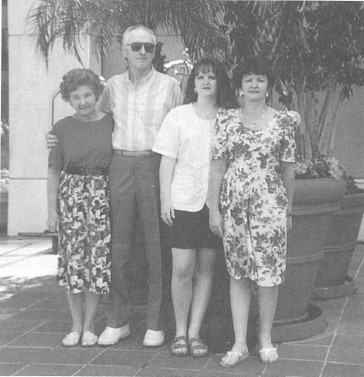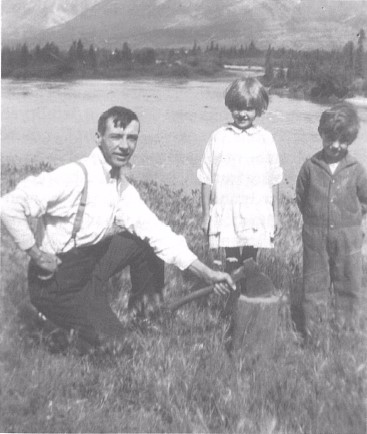Reginald Arthur Wilson was born Jan. 1, 1888, right at midnight when the bells were ringing, in Blackwell, Derbyshire. He was from a family of ten but one boy drowned when he was eight. His dad owned a store, a post office and a chicken farm of 5000 chickens. Then the family moved to South Wales where his dad worked in the mines.
When Dad (Reginald) was twelve years old, he was taken down into the mine. They were allotted so many cars to fill so all he had to do was sit in the dark in vertical pits. After that, when he was sixteen, his father took him to Johannesburg, South Africa, six weeks by boat to get there, and they worked in the gold mines. This trip was made twice. The English were foremen in the gold mines and the coolies did the work. Because he was bullying one of the coolies and pulled his pigtail (pigtails considered sacred at the time), he left the country to save his own life.
While sitting around the dinner table, Dad asked who would like to go to Canada. By a show of hands, majority ruled so the family came to Glace Bay. They didn’t stay in Glace Bay very long before returning to England. Then they did the same thing again, sitting around the dinner table for voting, and this time decided to go west. So the family all came out again except the two oldest girls who were married and stayed behind in Wales. Mom and Dad and seven kids arrived in Calgary in 1912.
Dad got a job up at Georgetown as company weighman. He batched with Ernie Mallabone and Tommy Humphries.
The war broke out and Dad joined up from Calgary. He went overseas to France and saw action at Vimy Ridge and Ypres.
Dad knew Mom’s family, the Morgans, from Wales and had held Mom on his lap when she was little; he was fourteen years older. When the war ended, he went to visit – actually they had
corresponded during the war. Dad was discharged in January and he went back to Mom’s family and they were married on the twenty-fifth of January. He brought her out to Canmore – a seventeen-year-old war bride. During the war, Georgetown had shut down so the men worked in the Canmore mines.
A year later, in 1920, the first child, Iris, arrived. Mom got homesick. She had to go show her mom her new daughter. The family moved back to Wales. Dad worked in the mine in Wales.
Bert was born over there, just across the street from his grandmother, Mrs. Morgan. He was only four pounds. Bert was delicate and Iris was sickly so Mom was very busy looking after them.
Iris says, “When Bert was born, Mom said she had a nice birthday present for me. I was hoping for a nice pair of white gloves and instead I was shown this new little baby brother. ” I thoroughly enjoyed playing little games and going to buy sweets from the store. The doctor had told my mother that I would not live for many more years; I used to take advantage of my grandmother by playing on her sympathy when I wanted a penny. If she refused the penny I would say, “You’ll be sorry when you look down on my cold dead face”.
Mom was very clever with her hands and Mom made Bert a blue velvet suit. We were over at my grandmother’s and Bert went out to play. So Gran looked out the window and saw a beautiful flower on his suit. “Isn’t he clever?” said Gran. Bert had really taken a pair of scissors and cut a big hole in his new suit and had put the flower stem in”.
We came back to Canada in 1927. The mine was working pretty well, about five days a week. But the trip, that was paid in installments, had to be repaid. So it took Mom up until the Depression hit to pay off that debt. So then it was a real struggle all through the Depression. We were given a dime once a year on the first of July and we gave that to Dad so he could go have a beer at the Legion.
In those days one pay cheque went to the company store and the next went for rent, utilities, etc. The rent was five dollars a month. Dad earned $5.05 a day. During the Depression Dad worked one day one week and two the next so he made $30 a month. In 1939, the first week that the mine opened full time – Dad was trampled by a horse, probably due to his inexperience (his job was hoistman) and the fact that he was handling a horse new to the mine. Dad received a compound fracture. Dad was paid compensation based on what he had earned the year before so that was very little. He was off work for nearly three years. When he went back to work he went to work in the lamphouse (maintaining the lamps).
At this time Bert was fighting fire at Pigeon Mountain for eleven cents an hour- however the food was great. Iris rode down on her bike to tell Bert that war was declared. Iris was working for the mine manager’s wife, for sixty-five cents a day, working from eight in the morning to anytime between six and nine at night.
In 1940 both Bert and Iris worked in the hospital for Dr. Sidney Gelfand. The pay was $30 a month for Bert, even in a thirty-one day month. This was for being janitor and many other duties. Iris got eighty-five cents a day for laundry. There were only wringer washers and the clothes had to be hung out on the line, brought in, ironed with a mangle, and folded, and put away. When Bert got the measles, he was quarantined and had to stay home; Iris did her work as well as Bert’s.
Then Iris started working in Banff and Bert went to the mine, the start of forty years, twenty five years on the locomotive (the old goat), and steam engineer in the boiler house the rest of the time. Then the mine closed down in 1979, black Friday, the thirteenth of July, and Bert went to the Banff Springs and was engineer up there for eleven and a half years. Bert worked fifty-three years of his life.
Bert married Anne Pollock, August 10, 1946. Anne was born here and left when she was a year and a half old, moving to Calgary. Anne’s dad worked in the mine here but he was hurt in the mines and got out of it. He worked in Calgary for Pat Burns Ranches, at feedlots and the elevator. Anne’s dad was in an explosion at the elevator; he survived but one man died. Because his face had been burned it was very sensitive to heat and cold. Her dad had come here from Poland when he was about thirteen. Her mom was born in Shephard, just outside of Calgary. Anne had two brothers, Ken and Stan. Stan worked for the CPR shops for many years and was head guy. He quit and became self-employed. After that he moved around B.C. Upon returning to Calgary he and his wife, Helen, ran the Mac’s Store in Forest Lawn. Stan has now passed away. Ken worked in Ashdown Hardware, then was a postal employee. Now Ken and Alice live in Carstairs.
Connie was born in the Canmore Hospital in 1951. She went to school here, graduated and went into training at the Calgary General Hospital as an X-ray technologist. She married Bryan McLaughlin. She has worked at the Canmore Hospital for the past twenty years, seeing a vast change, moving from a very small old hospital to a very modern brand new facility. She is the manager of Diagnostic Imaging at the present time. Connie and Bryan have two children: Karlea, born February 10, 1975, and Blake, born August 3rd, 1976. The two children attended school in Canmore. Karlea went to Ste. Anne de Bellevue, Quebec, where she graduated in Dental Hygiene. Blake is a trainer for the Montana’s restaurant chain. Karlea married Gasper Correia on June 28, 1997. May 10th, 2000, they were blessed with a six-pound baby boy who was born at the Canmore Hospital. His name is Jared Matthew. They all now reside in Calgary.

Reginald and Caroline Wilson 1966

Anne and Bert Wilson

Anne and Bert Wilson Karlea and Connie McLaughlin
In Canmore Seniors at the Summit, ed. Canmore Seniors Association, 2000, p. 302-304

